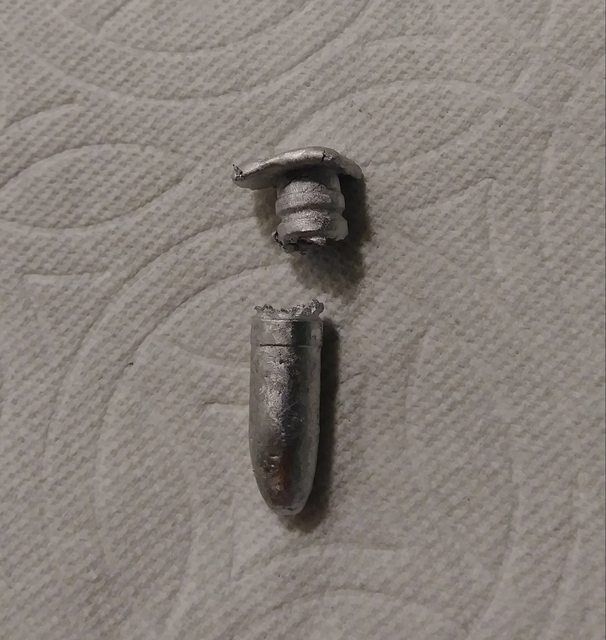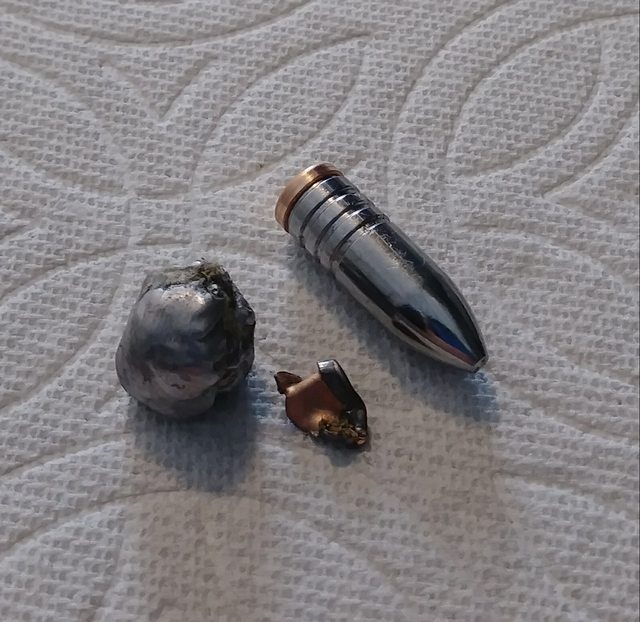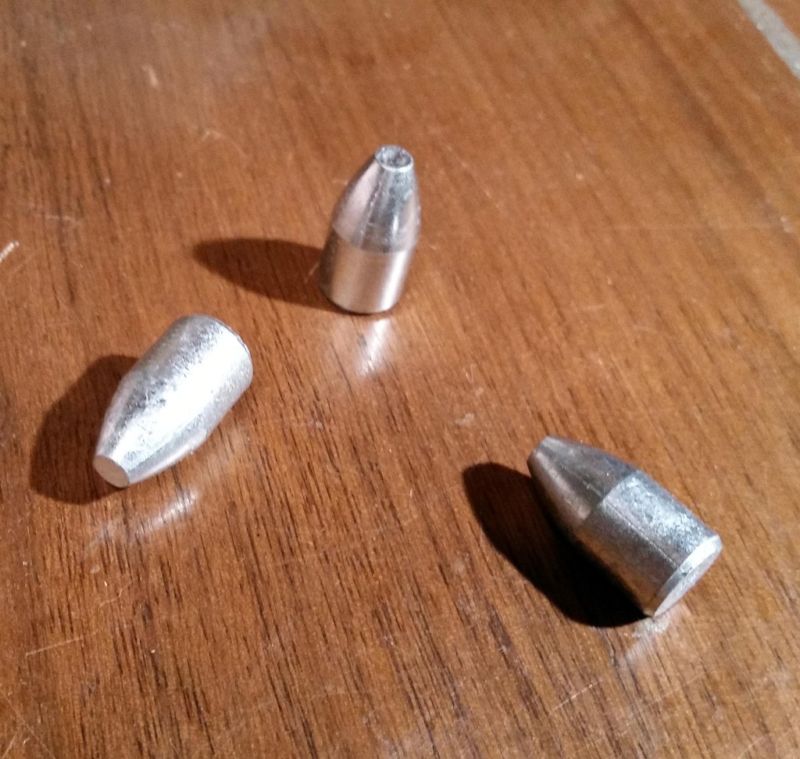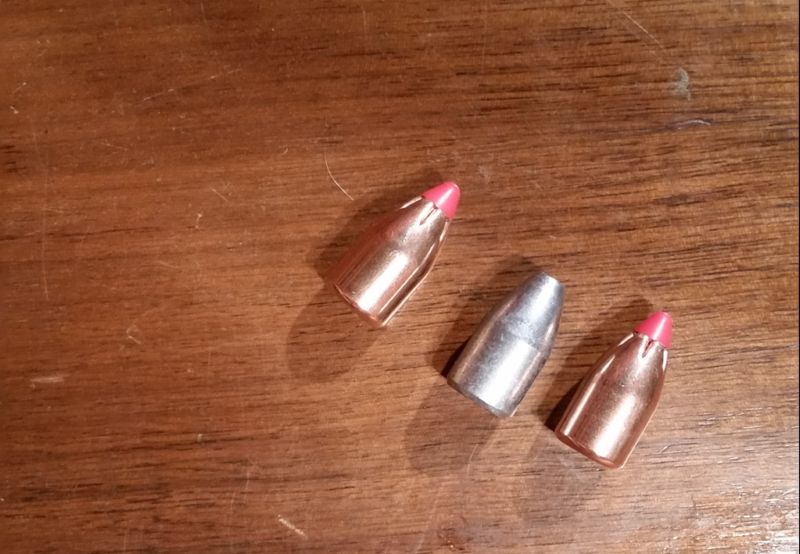You are using an out of date browser. It may not display this or other websites correctly.
You should upgrade or use an alternative browser.
You should upgrade or use an alternative browser.
Wheel weights good or bad?
- Thread starter Leadball
- Start date

Help Support Modern Muzzleloading Forum:
This site may earn a commission from merchant affiliate
links, including eBay, Amazon, and others.
- Joined
- Feb 13, 2020
- Messages
- 1,698
- Reaction score
- 2,174
BHN with W/W runs 11-13 on my Lee tester (air cooled) Ed
Idaholewis
Well-Known Member
- Joined
- Jun 30, 2017
- Messages
- 7,287
- Reaction score
- 10,288
They are to Hard for Blackpowder Velocities. I have shot them in the past, accuracy was reasonable in my Old Stainless 50 Cal, Keep in mind that Even if you get them to Shoot ok, You Won’t get much, if any Expansion, Unless you are Shooting a WALLOWED Out Hollow Point Type Bullet. Wheel Weights are a POOR Choice for Muzzleloader, You are MUCH better off to Get Pure Lead, and up to 20-1 Alloy for Real Blackpowder Velocities.
The problem is wheel weights are free for many of us. Imagine the year, 1765, you have a choice of using free wheel weights, what do you think would happen? My gut feeling is these would be fine for shooting patched balls out of a smooth bore. I know I did somehting with those when I was young and poor. I dont remember and odds are I did not know enough to notice. No worry about engaging the rifling or leading the bore in a musket or smoothbore. I found some round cedar wood balls I was going to try shooting. Smooth bore should handle about anything spherical you can ram down the barrel.
I think a consideration beyond hardness is that wheel weights use antimony while bullet alloys like 20-1 use tin. I forget why that matters. I think it has to do with leading the barrel with cartridge guns. There are a lot of warnings and cautions regarding wheel weigths on the internet. You can try google. The info is out there.
I think a consideration beyond hardness is that wheel weights use antimony while bullet alloys like 20-1 use tin. I forget why that matters. I think it has to do with leading the barrel with cartridge guns. There are a lot of warnings and cautions regarding wheel weigths on the internet. You can try google. The info is out there.
Last edited:
- Joined
- Nov 11, 2018
- Messages
- 8,356
- Reaction score
- 11,971
Does the antimony make the lead more brittle? Rather than just making it harder? I think the tin hardens but doesn't make the lead more brittle, less likely to frag on impact.The problem is wheel weights are free for many of us. Imagine the year, 1765, you have a choice of using free wheel weights, what do you think would happen? My gut feeling is these would be fine for shooting patched balls out of a smooth bore. I know I did somehting with those when I was young and poor. I dont remember and odds are I did not know enough to notice. No worry about engaging the rifling or leading the bore in a musket or smoothbore. I found some round cedar wood balls I was going to try shooting. Smooth bore should handle about anything spherical you can ram down the barrel.
I think a consideration beyond hardness is that wheel weights use antimony while bullet alloys like 20-1 use tin. I forget why that matters. I think it has to do with leading the barrel with cartridge guns. There are a lot of warnings and cautions regarding wheel weigths on the internet. You can try google. The info is out there.
- Joined
- May 19, 2005
- Messages
- 221
- Reaction score
- 113
Antimony does tend to make lead harder and more brittle. Tin hardens a little only but keeps the alloy very malleable.Does the antimony make the lead more brittle? Rather than just making it harder? I think the tin hardens but doesn't make the lead more brittle, less likely to frag on impact.
- Joined
- Feb 13, 2020
- Messages
- 1,698
- Reaction score
- 2,174
The problem wit antimony is it makes the boolit brittle depending on amount in your alloy not desirable with expansion of lead being the goal at BP speedsThe problem is wheel weights are free for many of us. Imagine the year, 1765, you have a choice of using free wheel weights, what do you think would happen? My gut feeling is these would be fine for shooting patched balls out of a smooth bore. I know I did somehting with those when I was young and poor. I dont remember and odds are I did not know enough to notice. No worry about engaging the rifling or leading the bore in a musket or smoothbore. I found some round cedar wood balls I was going to try shooting. Smooth bore should handle about anything spherical you can ram down the barrel.
I think a consideration beyond hardness is that wheel weights use antimony while bullet alloys like 20-1 use tin. I forget why that matters. I think it has to do with leading the barrel with cartridge guns. There are a lot of warnings and cautions regarding wheel weigths on the internet. You can try google. The info is out there.
So then, for the OP, if he is shooting an inline with sabots, wheel weights should be fine for practice. I did not consider how varied the guns and application are for muzzle loading. I dont have an inline, but; I do have some big smooth bores that use a lot of lead.
Yup, Shouldn't matter on paper to play. I was using Harvesters lead bullets to do the same in my Knight Bighorn. They were ok after I weighed and sorted them. I may purchase a similar mould and cast my own for consistency though.
The best use I found for wheel weights is this: I know a guy who uses them to make pistol bullets and he was willing to trade me one to one for lead after I made the ww into ingots. I ended up getting about 500 lbs of pure lead that way.
Idaholewis
Well-Known Member
- Joined
- Jun 30, 2017
- Messages
- 7,287
- Reaction score
- 10,288
Lyman #2 Alloy When you get your Mold to Hot and Dump that First few Bullets out until the Mold “Settles” Down 

Same Lyman #2 Alloy (Same Batch as Above) Captured in a Solid Block of Firewood.


Same Lyman #2 Alloy (Same Batch as Above) Captured in a Solid Block of Firewood.

- Joined
- Dec 24, 2009
- Messages
- 15,021
- Reaction score
- 6,882
Makes a good smooth side bullet for sabots if you get the metplat size right. Accurate offers the smooth side molds for sabots. Wide metplat and enough speed is pretty nasty if you want great penetration and reasonably good tissue displacement. A guy on another board made some SST type clones. I believe it was from a Accurate mold. WW lead should work well for those as plinkers.




Matthew323
Well-Known Member
- Joined
- Feb 15, 2020
- Messages
- 1,428
- Reaction score
- 1,477
A lot of shooters over on the ALR forum use wheelweight metal to cast round balls for their smoothbores.
1.) Practice shooting, cheaper than pure lead.
2.) Shooting in matches, such as woods walks where there will be a lot of shots taken. Again, less expensive.
3.) Big game hunting for bear, elk, and moose where the hunter wants more penetration than pure lead will provide. This is guys shooting mostly 16, 12, 11, and 10 bore flintlocks.
1.) Practice shooting, cheaper than pure lead.
2.) Shooting in matches, such as woods walks where there will be a lot of shots taken. Again, less expensive.
3.) Big game hunting for bear, elk, and moose where the hunter wants more penetration than pure lead will provide. This is guys shooting mostly 16, 12, 11, and 10 bore flintlocks.
Idaholewis
Well-Known Member
- Joined
- Jun 30, 2017
- Messages
- 7,287
- Reaction score
- 10,288
Some people even use them to balance wheels!
Imagine that
Plenty of Centerfire Cartridge Casters use it for Casting Rifle Bullets, Water Quenched, and Ran to 2,500 Fps, it seems quite popular there. I chose Lyman #2 Alloy for that Application for Consistency
Antimony over time will make lead stronger over time but for hardness tin should be used in the alloy to harden cast bullets as noted from other writers. The problem I have had with wheel weights is the different level of Antimony say 2-6% as measured in a lab. I have used lead/tin bullets for both sabot and center fire loading.
Similar threads
- Replies
- 1
- Views
- 85
- Locked
- Replies
- 87
- Views
- 2K




